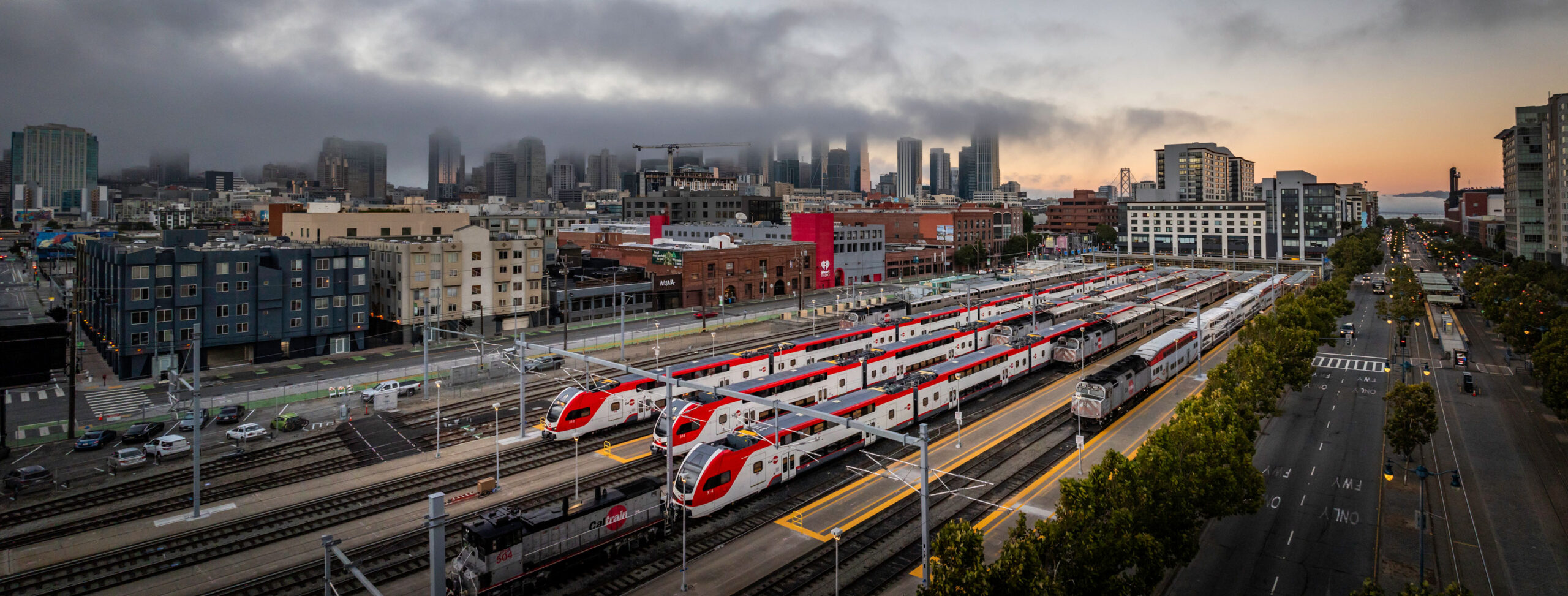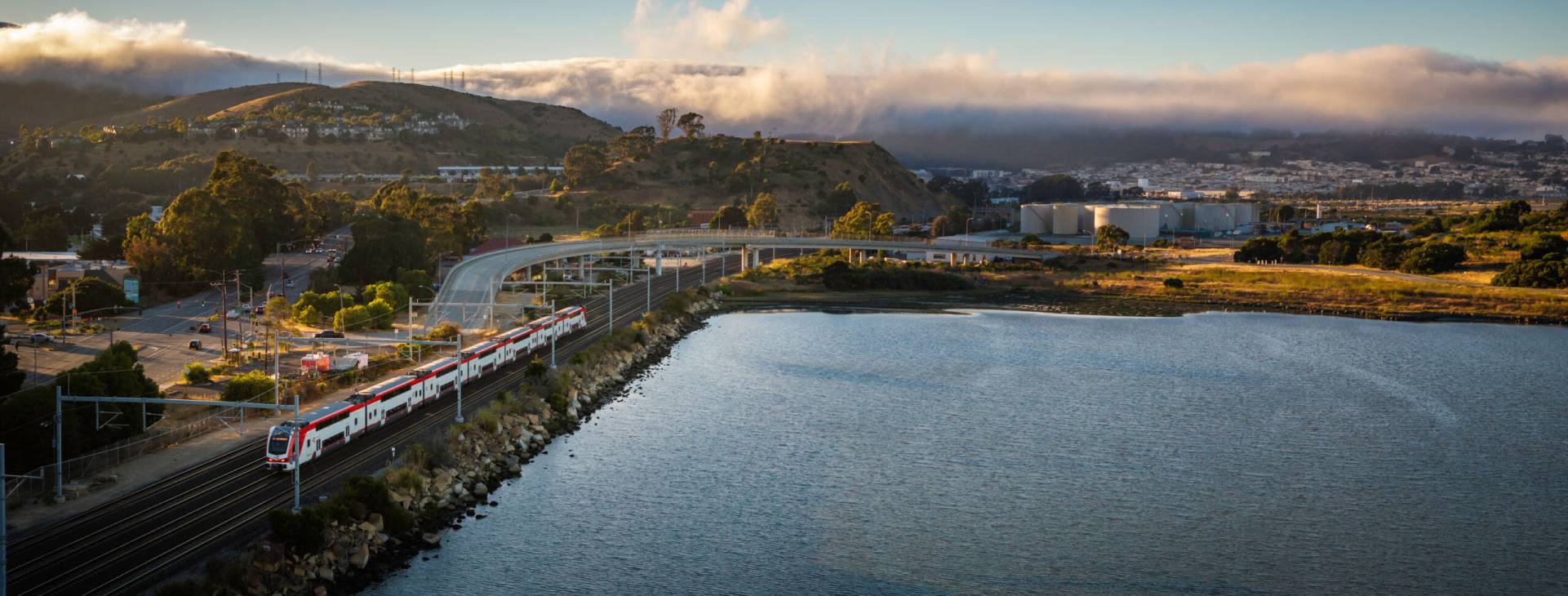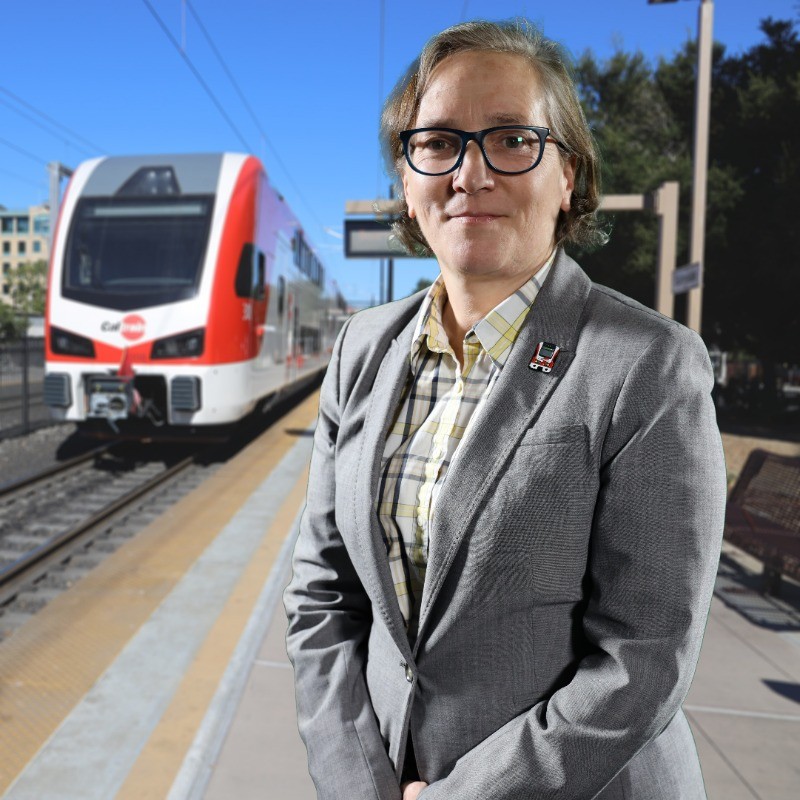
Improving performance and quality of life for communities along the corridor
Strategies that powered Caltrain’s diesel to electric transformation
By Michelle Bouchard, Executive Director | Caltrain
For 160 years, passenger rail has provided vital connections for people and goods throughout the San Francisco Peninsula. Caltrain is committed to building on this legacy by improving connectivity to the statewide rail network, contributing to the region’s economic vitality and partnering with local communities to ensure that diverse constituencies receive a world-class travel experience.
To promote Caltrain’s long-term goals to improve system performance and enhance quality of life for communities along the corridor, we recently transitioned our fleet from diesel to electric, launching our fully electric mainline between San Francisco and San Jose. This transformation has changed every aspect of our system, from infrastructure and fleet technology to how we operate and serve our communities.
Our 51-mile electric corridor is powered by an overhead catenary system that delivers clean energy to Caltrain’s electric multiple unit trainsets, using regenerative braking to return some of that energy to the grid and ultimately reduce our carbon footprint. The advanced EMU trains are quieter and travel faster than diesel-powered locomotives, allowing our passengers to enjoy more frequent service, shorter travel times and greater reliability. Each EMU trainset also incorporates crash energy management technology to minimize collision impacts, and our 41 grade crossings are now equipped with wireless train detection and signaling systems that communicate with nearby vehicles to reduce collision risks and improve traffic flow.
Together, these technologies set a new U.S. industry standard for passenger experience, operational efficiency and air quality in commuter rail. Four key strategies were used to drive successful project delivery and achieve 100% electrification:
- Prioritize passenger needs
- Communicate proactively and transparently about the project
- Seize opportunities to build momentum
- Adapt swiftly and strategically to achieve goals
Prioritize passenger needs
Throughout each step of the electrification project, the essential role of our passengers was prioritized.
Electrification not only promotes sustainability but also significantly enhances the passenger experience. Our new Stadler KISS double-deck trains are designed with passenger comfort in mind, featuring modern amenities such as Wi-Fi, spacious seats with power outlets and bicycle storage space. These improvements create a more enjoyable and accommodating travel environment.
And because electric trains accelerate and decelerate faster and travel at higher speeds than diesel trains, Caltrain service is now faster and more frequent. Sixteen of our 31 stations now have trains arriving every 10 to 15 minutes during peak hours, while most other stations receive service every 30 minutes throughout the day. Weekend train frequency has doubled to every 30 minutes, and express service from San Francisco to San Jose now takes just one hour. We anticipate the more frequent and faster service will significantly increase the number of new and repeat customers.
Since launching electrified service in September 2024, Caltrain’s ridership has grown by 41% compared to the same time last year.
Communicate proactively and transparently
Proactive and transparent communication was essential for the successful development of the Caltrain project. By clearly conveying the transformative benefits of electrification, we attracted investment and funding while garnering public support. Our public education campaigns emphasized improvements in air quality, traffic congestion relief and noise pollution reduction for all communities along the rail line.
Key benefits communicated to the public included the significant emissions reduction achieved by our electric multiple unit trainsets, equivalent to removing 55,000 cars from California’s Highway 101 annually. Also, Caltrain’s electrification paves the way for future mobility projects including a proposed 1.3-mile extension to downtown San Francisco and a potential southward extension using battery-electric trains to Gilroy with demonstrations trips to Salinas.
Our team made sure that important project information was easily accessible to the public. In addition to hosting public meetings, we provided project timelines and updates through our website.
By communicating the benefits of electrification including improvements to air quality, enhanced passenger experience, operational efficiencies and future mobility options, we helped stakeholders understand the advantages of electrification. The widespread support and engagement from stakeholders helped drive this project to completion.
Seize opportunities to build momentum
Our initiative to deliver electrification to three of the most densely populated counties in the country spanned 25 years. Throughout the process, we seized opportunities to accelerate the timeline and build momentum for the project. Key to securing environmental clearance was our creation of the Local Policy Maker Group (LPMG) in 2012. We formed the group to demonstrate our commitment to stakeholder engagement and regulatory compliance, but we found it also helped streamline the environmental process.
Representatives from 17 cities and the three counties along the Caltrain corridor were responsible for providing local feedback and guidance on the electrification project. Their participation supported the environmental process and kept our project moving forward. In fact, the LPMG was so successful that we added representatives from two more cities along the corridor and the group continues to meet on a bi-monthly basis.
Building on the momentum of the environmental phase, we seized another opportunity to keep the project moving forward in 2017. We issued limited notices to proceed to two major contractors until all funding was secured so that construction could advance. We broke ground in July 2017, allowing construction to commence on schedule.

"Completing the first major rail electrification project in the U.S. in a generation taught us that success hinges not on avoiding challenges but on adapting swiftly and strategically to overcome them."
Adapt swiftly and strategically to meet goals
Effective project management and strategic adaptability were key to overcoming the challenges faced during the Caltrain electrification project, ensuring its successful delivery despite unforeseen obstacles. For example, in December 2021 after four years of construction, escalating costs and supply chain disruptions due to COVID-19 were impacting our ability to deliver the project according to the original budget and schedule. To resolve those issues, our electrification program underwent a reorganization. We recalculated the budget, revised the schedule and presented the overhauled plan to our board of directors, who approved it unanimously. With our oversight board’s help, we secured an additional funding to bring the project to fruition.
To combat supply chain disruptions, our project team worked closely with contractors to identify alternative suppliers, and, in some cases, the contractors manufactured parts in-house to advance the project.
Completing the first major rail electrification project in the U.S. in a generation taught us that success hinges not on avoiding challenges but on adapting swiftly and strategically to overcome them. We communicated the benefits of electrification, found ways to maintain momentum, prioritized the needs of our passengers and kept the project moving forward.
A new standard for sustainability
The Caltrain electrification project stands as a testament to the power of strategic adaptability and proactive communication. By prioritizing passenger needs, seizing opportunities to build momentum and overcoming challenges with innovative solutions, we have set a new standard for U.S. commuter rail. As other rail systems embark on similar journeys, we hope our experience will inspire and guide them in achieving their ambitious goals and to serve as a resource. The successful completion of this project not only transforms the travel experience for our passengers but also paves the way for a better, more efficient future in rail transportation.
ABOUT THE AUTHOR

Michelle Bouchard
Executive Director
Caltrain
Michelle Bouchard is the Executive Director of Caltrain and has more than 30 years of experience in the transit industry.
Contact her at [email protected].
